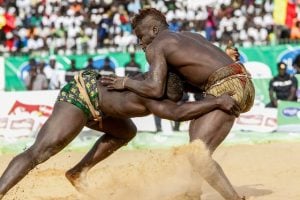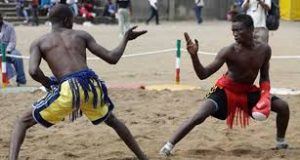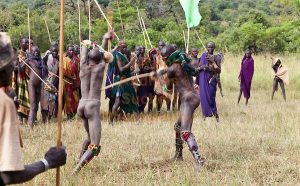
When we talk about martial arts, people usually make a straight connection with Japan or China. This impression is mainly due to mainstream movies from the past century. Not to take anyway from the rich history of Eastern martial arts, but they’re not the only creed of fighting systems in the world. Actually, most regions in the world have their own brand of martial art styles. BJJ is so popular that there’s rarely someone that’s not aware of it. Europe has been marked by wrestling since the days of the ancient Greek Olympic Games. America has plenty of boasting rights when it comes to boxing. But are you aware of African martial arts?
Make no mistake about it, African martial arts do exist and are as diverse as the continent itself. Not only they exist but some have very long traditions. Their origins are impossible to pinpoint precisely. As with every other spot in the world, African martial arts are based on a few distinct categories. Continuing on in this article, we bring you the most important grappling, striking and weapon-based fighting styles of Africa.
Grappling Based on African Martial Arts
Call me biased, but I’m going to start with the grappling oriented African martial arts. TO begin with, let’s discover the world of Laamb Wrestling. This is Senegalese grappling art. It’s based on takedowns and similar to Greco-Roman wrestling. Loosely translated as “to fight”, Laamb wrestling is a colorful and ritualistic feat. Matches begin with dancing and shamanic rituals before the fighters entangle. Both fighters are dressed in loincloths and decorated with talismans believed to have magical properties. Fights are scored based on the success of takedowns and even punches are allowed during professional matches.
Another distinct African grappling style is Evala. It is another art based on takedown prowess. In some parts of Africa, Evala is not just a competitive sport geared toward entertainment. It is part of an initiation ritual into manhood. In Togo, older boys have to wrestle in Rvala in order to reach manhood and prove themselves. It bears resemblance to ancient Spartan ways, with boys being separated from their parents during intense training. Unlike Spartan customs, though, Evala training takes place only a week before the boys wrestle.
There is evidence of similar wrestling based styles from Egypt and Sudan as well. Whatever the wrestling style was, there was a clear objective that was common to them all – to pin the opponent. One exception is a grappling style characteristic to Southeast Africa, in which contestants start kneeling or seated. The uniqueness of this style lies in the fact that wrestlers only used a single arm in their matches.
In African martial arts, there are also numerous traditions of women wrestlers. As with their male counterparts, reasons for combat vary, from harvest rituals to courtship strategies.
Striking Based African Martial Arts
From a striking standpoint, the art of Dambe is a major one in Africa. It is a boxing based style of fighting with strong spear fighting relations. In honor of ancient spear fighting traditions, both arms of a Dambe fighter have roles. One is dubbed “the spear” and is wrapped in twine or a glove. The other bears the name of “shield” and is left bare, mostly playing a defensive role. Matches are organized in three-round bouts, with the aim being to “kill” the opponent. Dambe considers a “kill” to be a knockdown, which, given that only one arm was used to punch, was quite a difficult task.
A bare-knuckle boxing-like art coming from Africa is Musangwe. It is specific to South Africa and in particular, The Venda people. They have a centuries-long tradition of practicing art. Traditionally, fights are held every Christmas in the Chifude Valley. There are only three rules that decide when a fight gets stopped. One is when blood appears, the second is in case of a knockout and the final is due to one fighter surrendering. Musangwe boxers fight in searing heat, and the spectacle is witnessed by thousands of people.
Another very interesting representative of African martial arts is Ladjia. It is a martial art that is very similar to Brazilian capoeira. Ladjia is played along with percussive instruments (drums or sticks). It consists of highly acrobatic moves, including punching, kicking, and eye-gouging. As with capoeira, the tempo of the music dictates the pace of the fight. A victory is earned when one fighter gets the other one on their backs.
Weapon Based on African Martial Arts
Martial arts styles based on the use of weapons are very prevalent on the continent of Africa. The rich tradition of spear use has influenced a lot of the stick fighting styles specific to Africa.
Egypt’s stick fighting system is known as Tahtib. It is one more capoeira-like art but including sticks. Considered to be a remnant of pharaonic Egypt, Tahtib is also performed with music. Ethiopia is considered to have the fiercest and most aggressive Tahtib stick fighters on the continent.
More in line with the tradition of spear utilization, Donga is a martial art involving the use of a long stick. It is specific to the Suri tribesmen. They use the long sticks to herd and defend their cattle. There is but one rule in Donga – do not kill the opponent. Everything else is permitted. Donga matches are violent and bloody affairs. There are usually 20-30 participants on each side of a Donga competition, each waiting their turn to fight.
Bearing resemblance to Escrima, Nguni uses two sticks. It is common to the Zulu tribe. Much like Dambe, fighters use one stick for offense, and the other for defense. The hand holding the defensive stick also carries a small shield. Bloodshed, a knockout or surrender bring an end to a match.
These are just some examples of African martial arts. Given the diversity of the continent, it is easy to understand how there are countless other styles and variations. Do you know of any unique African martial art? Sound off!
https://bjj-world.com/difference-japanese-jiu-jitsu-bjj/


![Darce Choke Encyclopedia – Origins, Mechanics and Variations [2025] BJJ, choke, Brabo, BJJ Darce Choke, D'arce Choke, Darce BJJ Choke](https://bjj-world.com/wp-content/uploads/2017/11/JungPoirierLeeYahoo-218x150.jpg)












![Modernized Headquarters Passing Shawn Melanson DVD Review [2025] Modernized Headquarters Passing Shawn Melanson DVD Review](https://bjj-world.com/wp-content/uploads/2025/04/headquarters-passing-shawn-melanson-dvd-review-218x150.png)
![4 Weeks To A Better Guard Travis Stevens DVD Review [2025] 4 Weeks To A Better Guard Travis Stevens DVD Review](https://bjj-world.com/wp-content/uploads/2025/04/4-weeks-to-a-better-guard-travis-stevens-dvd-review-218x150.png)
![DONE! Gordon Ryan Retiring—and Danaher Might Not Be Far Behind! [2025] Gordon Ryan Retiring—and Danaher Might Not Be Far Behind!](https://bjj-world.com/wp-content/uploads/2025/04/LEG-GRABS-3-1-218x150.png)

![6 Most Essential Skills Base Top Dima Murovanni DVD Review [2025] 6 Most Essential Skills Base Top Dima Murovanni DVD Review](https://bjj-world.com/wp-content/uploads/2025/04/essential-skills-base-top-dima-murovanni-dvd-review-218x150.png)

![Closed Guard Reintroduced Adam Wardzinski DVD Review [2025] Closed Guard Reintroduced Adam Wardzinski DVD Review](https://bjj-world.com/wp-content/uploads/2025/01/closed-guard-reintroduced-adam-wardzinski-dvd-review-324x235.png)
![6 Most Essential Skills Base Top Dima Murovanni DVD Review [2025] 6 Most Essential Skills Base Top Dima Murovanni DVD Review](https://bjj-world.com/wp-content/uploads/2025/04/essential-skills-base-top-dima-murovanni-dvd-review-100x70.png)
![Jeff Higgs Self Defense Guard BJJ DVD Review [2024] Jeff Higgs Self Defense Guard BJJ DVD Review](https://bjj-world.com/wp-content/uploads/2024/09/jeff-higgs-self-defense-guard-bjj-dvd-review-100x70.png)


![No-Gi Grapplers Guide To Front Headlock Joel Bane DVD Review [2025] No-Gi Grapplers Guide To Front Headlock Joel Bane DVD Review](https://bjj-world.com/wp-content/uploads/2025/03/no-gi-front-headlock-joel-bane-dvd-review-100x70.png)
![Don’t Stand Up Chris Wojcik DVD Review [2024] Don't Stand Up Chris Wojcik DVD Review](https://bjj-world.com/wp-content/uploads/2024/11/dont-stand-up-chris-wojcik-dvd-review-100x70.png)
![Assassin Choke Baret Yoshida DVD Review [2024] Assassin Choke Baret Yoshida DVD Review](https://bjj-world.com/wp-content/uploads/2024/10/assassin-choke-baret-yoshida-dvd-review-100x70.png)
![Woj Lock the World Chris Wojcik Ankle Locks DVD Review [2024] Woj Lock the World Chris Wojcik Ankle Locks DVD Review](https://bjj-world.com/wp-content/uploads/2024/12/woj-lock-the-world-chris-wojcik-dvd-review-100x70.png)




![Charles Allan Price Building Workouts For BJJ DVD Review [2024] Charles Allan Price Building Workouts For BJJ DVD Review](https://bjj-world.com/wp-content/uploads/2024/09/charles-allan-price-building-workouts-for-bjj-review-100x70.png)
![Osoto Gari for Jiu Jitsu Jackson Nagai DVD Review [2024] Osoto Gari for Jiu Jitsu Jackson Nagai DVD Review](https://bjj-world.com/wp-content/uploads/2024/10/osoto-gari-for-jiu-jitsu-jackson-nagai-dvd-review-100x70.png)
![Knee Lever John Wayne Sweep Adam Wardzinski DVD Review [2024] Knee Lever John Wayne Sweep Adam Wardzinski DVD Review](https://bjj-world.com/wp-content/uploads/2024/12/john-wayne-sweep-adam-wardzinski-dvd-review-100x70.png)
![The Whole Omoplata Enchilada Lyanne Perez DVD Review [2024] The Whole Omoplata Enchilada Lyanne Perez DVD Review](https://bjj-world.com/wp-content/uploads/2024/11/whole-omoplata-enchilada-lyanne-perez-dvd-review-100x70.png)



![Simplify the System Side Scissor Brian Glick DVD Review [2024] Simplify the System Side Scissor Brian Glick DVD Review](https://bjj-world.com/wp-content/uploads/2024/09/side-scissor-brian-glick-dvd-review-2024-100x70.png)

![Crush The Guard Vagner Rocha DVD Review [2024] Crush The Guard Vagner Rocha DVD Review](https://bjj-world.com/wp-content/uploads/2024/10/crush-the-guard-vagner-rocha-dvd-review-100x70.png)
![X-Guard Trickery Kyle Sleeman DVD Review [2025] X-Guard Trickery Kyle Sleeman DVD Review](https://bjj-world.com/wp-content/uploads/2025/03/x-guard-trickery-kyle-sleeman-dvd-review-100x70.png)

![10th Planet Leg Locks Jeremiah Vance DVD Review [2025] 10th Planet Leg Locks Jeremiah Vance DVD Review](https://bjj-world.com/wp-content/uploads/2025/01/10th-planet-leg-locks-jeremiah-vance-dvd-review-100x70.png)
![Eoghan O’Flanagan Bundle Down Right Sloppy Jiu-Jitsu Review [2024] Eoghan O'Flanagan Bundle Down Right Sloppy Jiu-Jitsu Review 2024](https://bjj-world.com/wp-content/uploads/2024/09/down-right-sloppy-jiu-jitsu-eoghan-oflanagan-bundle-100x70.png)
![360 Degrees Guard Retention Thiago Abud DVD Review [2024] 360 Degrees Guard Retention Thiago Abud DVD Review](https://bjj-world.com/wp-content/uploads/2024/10/360-degrees-guard-retention-thiago-abud-dvd-review-100x70.png)

![Best Marcelo Garcia Techniques by Team Marcelo Garcia DVD Review [2025] Best Marcelo Garcia Techniques by Team Marcelo Garcia DVD Review](https://bjj-world.com/wp-content/uploads/2025/02/best-marcelo-garcia-techniques-dvd-review-100x70.png)